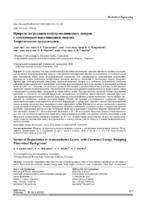| dc.contributor.author | Гаркавенко, В. А. | |
| dc.contributor.author | Мокрицкий, А. С. | |
| dc.contributor.author | Маслов, О. В. | |
| dc.contributor.author | Соколов, А. В. | |
| dc.coverage.spatial | Минск | ru |
| dc.date.accessioned | 2020-08-04T10:51:26Z | |
| dc.date.available | 2020-08-04T10:51:26Z | |
| dc.date.issued | 2020 | |
| dc.identifier.citation | Природа деградации полупроводниковых лазеров с электронным накачиванием энергии. Теоретические предпосылки = Nature of Degradation in Semiconductor Lasers with Electronic Energy Pumping. Theoretical Background / В. А. Гаркавенко [и др.] // Наука и техника. – 2020. – № 4. – С. 311-319. | ru |
| dc.identifier.uri | https://rep.bntu.by/handle/data/77412 | |
| dc.description.abstract | В статье отмечено, что при достижении определенных критических значений плотности мощности лазерного излучения в полупроводниковых лазерах с электронным накачиванием энергии, изготовленных из монокристаллов ряда соединений, имеет место катастрофическая деградация. Она сопровождается механическим разрушением поверхности торцов резонатора, необратимым падением мощности излучения и увеличением порога генерации. Причем при катастрофической деградации полупроводниковых лазеров под действием собственного излучения в монокристалле происходят существенные изменения кристаллической структуры: плотность дислокаций достигала более 1012–1015 см–2. Показано, что исходная плотность дислокаций и критическая плотность мощности собственного излучения обратно пропорциональны. Таким образом, процесс деградации полупроводниковых лазеров прямо связан с генерацией и размножением дислокаций во время работы лазера. При критических значениях мощности лазерного излучения и плотности дислокаций происходит механическое разрушение кристаллической решетки кристалла. Для выяснения предложенного механизма деградации полупроводниковых лазеров необходимо учесть влияние дислокаций на оптические свойства полупроводников. Обычно это влияние рассматривается следующим образом. Дислокации вызывают появление поля локальных деформаций и, кроме того, образуют области пространственного заряда, которые окружают ядро дислокации в виде заряженной трубки. Предлагается модель исследуемого явления: в ядре дислокации возникают большие напряжения, ведущие к смещению отдельных атомов и деформации решетки кристалла. Деформация решетки в ядре дислокации приводит к локальному изменению ширины запрещенной зоны. Это изменение порядка 10–2 эВ для винтовой дислокации и 10–1 эВ для краевой. Механизм данного изменения состоит в том, что упомянутая деформация приводит к множественному разрыву электронных связей и увеличению в ядре дислокации концентрации электронов примерно до 1018 см–3. Разработанная аналитическая модель механизма деградации позволит производить выбор полупроводника и оценку режима работы лазера в условиях повышенной мощности излучения. | ru |
| dc.language.iso | ru | ru |
| dc.publisher | БНТУ | ru |
| dc.title | Природа деградации полупроводниковых лазеров с электронным накачиванием энергии. Теоретические предпосылки | ru |
| dc.title.alternative | Nature of Degradation in Semiconductor Lasers with Electronic Energy Pumping. Theoretical Background | ru |
| dc.type | Article | ru |
| dc.identifier.doi | 10.21122/2227-1031-2020-19-4-311-319 | |
| local.description.annotation | Catastrophic degradation takes place in case of reaching critical values of laser radiation density power in semiconductor lasers with electronically pumped energy made from single crystals of some compounds. It has been accompanied by mechanical destruction of the surface at resonator ends, an irreversible decrease in radiation power and an increase in generation threshold. Moreover, during the catastrophic degradation of semiconductor lasers under the action of intrinsic radiation, significant changes in the crystal structure occur within the single crystal: dislocation density reaches a value more 1012–1015 cm–2. It has been shown that initial density of dislocations and critical power density of the intrinsic radiation are inversely proportional. Thus, the degradation process of semiconductor lasers is directly related to generation and multiplication of dislocations during laser operation. Mechanical destruction of a crystal lattice occurs at critical values of laser radiation power and dislocation density. To clarify the proposed mechanism for the degradation of semiconductor lasers, it is necessary to take into account an effect of dislocations on optical properties of semiconductors. Typically, this effect is considered as follows: dislocations cause an appearance of a local deformation field and, in addition, form space-charge regions that surround a dislocation core in the form of a charged tube. The paper proposes a model of the phenomenon under study: large stresses arise in the dislocation core, leading to a displacement of individual atoms and deformation of the crystal lattice. Lattice deformation in the dislocation core leads to a local change in the width of a forbidden band. This change value is about 10–2 eV for a screw dislocation and 10–1 eV for a boundary dislocation. The mechanism of this change is that aforementioned deformation leads to a multiple rupture of electronic bonds and an increase in the electron concentration in the dislocation core to approximately value 1018 cm–3. The developed analytical model of the degradation mechanism allows to perform selection of a semiconductor and estimation of a laser operating mode under conditions of increased radiation power. | ru |

